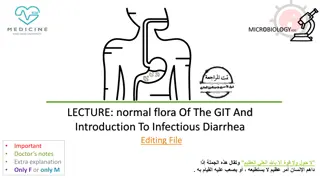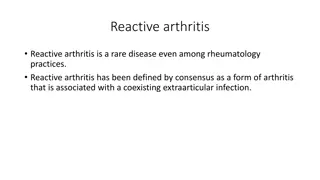Normal Flora of the Gastrointestinal Tract & Infectious Diarrhea
Normal flora in the gastrointestinal tract play a crucial role in maintaining health, but can also cause disease in certain conditions. This lecture covers the common flora in the GIT, their role in diseases, various types of acute diarrheal illnesses, epidemiology, and management of bacterial agent
1 views • 26 slides
Yersinia: Characteristics, Diseases, and Identification
The genus Yersinia includes various species, with Yersinia pestis causing plague and others causing diarrheal diseases. Yersinia organisms are gram-negative rods, often associated with serious infections. Learn about Yersinia pestis, its transmission, identification, morphology, and antigenic struct
0 views • 32 slides
The Normal Flora of the Gastrointestinal Tract and Infectious Diarrhea
Explore the common normal flora of the gastrointestinal tract (GIT) and how they play a role in health and disease, specifically focusing on infectious diarrhea. Learn about different types of acute diarrheal illnesses, epidemiology, host defenses against GI infections, and the pathogenesis of bacte
0 views • 38 slides
Insights into the Plague: Epidemiology, Etiology, and Outbreaks
The Plague, caused by Yersinia pestis, has a chilling history spanning pandemics like the Justinian Plague and the Black Death. Understanding its etiology, family, and pathogenicity is crucial. This deadly disease has had notable outbreaks in India, emphasizing the importance of recognizing its host
1 views • 24 slides
Yersinia Pestis: The Bacterium Behind the Black Death
Yersinia pestis, the causative agent of the infamous Black Death, is a Gram-negative coccobacilli bacterium. It is transmitted through fleas and affects lymph nodes, causing bubonic plague. This article explores its general characteristics, pathogenesis, virulence factors, laboratory diagnosis, and
0 views • 18 slides
The Devastating Impact of the Bubonic Plague in Medieval Times
The Bubonic Plague, caused by the bacterium Yersinia pestis, ravaged Western Europe during the late Middle Ages, resulting in over 75 million deaths. Spread through rats carrying infested fleas, the disease caused agonizing swellings and ultimately death, with no known cure in the 1300s. The unsanit
0 views • 11 slides
Reactive Arthritis: Symptoms, Diagnosis, and Treatment
Reactive arthritis, a rare disease associated with infections like Chlamydia, Salmonella, and Yersinia, presents with musculoskeletal features such as oligoarthritis, enthesitis, and dactylitis. Extraarticular manifestations include eye involvement and genitourinary symptoms. Diagnosis involves lab
0 views • 9 slides
Acute Diarrheal Illness and Gastrointestinal Infections
Acute diarrheal illness is a common issue globally, leading to significant morbidity and mortality. This lecture covers the types of acute diarrhea, host defenses, pathogens like E. coli, Campylobacter, and Yersinia, and their management. It also discusses microbiological diagnosis methods, food poi
2 views • 30 slides
Role of Normal Flora & Pathogens in GI Infections
Normal flora in the gastrointestinal tract play a crucial role in health and disease. This article delves into the composition of normal flora, their impact on disease prevention, epidemiology of GI infections, and management of pathogens like E. coli, Campylobacter, Yersinia, and Clostridium diffic
0 views • 39 slides








